| |
Glossary of Coral Reef Terminology - E
EANx ( Enriched Air Nitrox ) - a breathing gas mixture for scuba divers which has a percentage of oxygen greater than 21 percent as is found in normal air. This mixture allows longer bottom times at limited depths |
early life history - the stages from egg to juvenile in fish development |
Eastern tropical Pacific Seascape (ETPS) - a coastal and marine region of 2.1 million square kilometers (roughly 810,815 square miles) that includes the Exclusive Economic Zones (EEZs) of Costa Rica, Panama, Colombia, and Ecuador. The ETPS also encompasses interspersed international waters, including the islands of Galapagos, Malpelo, Gorgona, Cocos, and Coiba |
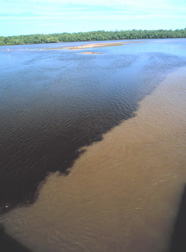
An ebb current carrying clear and muddy waters into the Gulf of Mexico. (Photo: William Folsom, NOAA
|
ebb current (ebb) - the movement of a tidal current away from shore or down a tidal river or estuary |
ebb strength - phase of the ebb tidal current at the time of maximum speed; also, the speed at this time |
ebb tide - that period of tide between a high water and the succeeding low water; falling tide |
ecad - a non-inheritable plant or animal form produced in response to particular habitat environmental factors; an environmentally induced form |
ecdysone - a molting hormone of arthropods. It stimulates growth and ecdysis (molting) |
Ecdysozoa - the ecdyzoans comprise one of the major and largest protostome groups within the animal kingdom. It includes both the arthropods and the nematodes, as well as lesser groups such as rotifers, cephalorhynchs (which include priapulids, kinorhynchs, and loriciferans), and onychophorans. Ecdysozoans build a cuticle, an outer layer of organic material that functions as a lightweight flexible exoskeleton. The name Ecdysozoa refers to the fact that many members of this group regularly shed their cuticle, a process called ecdysis |
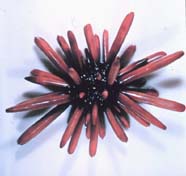
A pencil urchin of the phylum Echinodermata.
|
Echinodermata - an animal phylum that contains starfishes, sea cucumbers, sand dollars, brittlestars, basket stars, sea lilies, feather stars, and sea urchins. Adults exhibit pentamerous radial symmetry, secondarily derived from a bilateral ancestor. They are not at all related to the other radiate phyla, such as the Cnidaria |
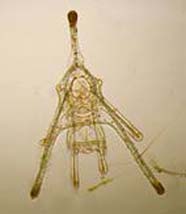
Free-swimming echinopluteus sea urchin (Echinocardium cordatum) larva feeds on microplankton captured with its ciliated arms. (Photo: Jan Parmentier)
|
echinopluteus larva - a larval form of some echinoderms |
Echiura - an animal phylum that contains the echiurans or spoonworms. Some species inhabit coral crevices. Echiurans are deposit feeders |
echo sounder - an instrument for determining the depth of water by measuring the time of travel of a sound-pulse from the surface of a body of water to the bottom and back |
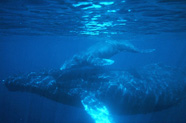
Recent studies indicate that humpback whales, in a manner similar to dolphins, may use echolocation to obtain information about their environment. (photo: Dave Glickman)
|
echolocation - the sonar-like ability used by bats, dolphins, some whales, and two groups of cave-dwelling birds to detect objects in their environment. Using echolocation, the animal emits high-frequency sounds that reflect off of an object and return to the ears or other sensory receptors |
ecocline - a gradual and continuous change in environmental conditions of an ecosystem or community; gradual transition between ecotypes; a continuous change in form as a response to a continuous change in an environment |
ecodeme - an intrabreeding population occupying any specified ecological habitat |
ecological efficiency - the percentage of energy in biomass produced by one trophic level that is incorporated into biomass by the next highest trophic level |
ecological equivalent - a different species that occupies a similar ecological niche in a similar ecosystem in a different part of the world |
ecological genetics - the study of genetics in the context of the interactions among organisms and between the organisms and their environment. It studies phenotypic evolution in natural populations.The traits studied are related to those which affect an organism's survival and reproduction (fitness) |
ecological isolation - a form of reproductive isolation in which two closely-related species are separated by what is often a slight difference in the niches they occupy |
ecological resilience - a measure of resistance to ecological disturbance and the speed of return to the equilibrium state of an ecosystem; also called "ecosystem resilience" |
ecological species - a concept of species, in which a species is a set of organisms adapted to a particular ecological niche |
ecology - the study of the interrelationships between organisms and their environment, including the biotic and abiotic components |
ecomorph - a local population or group whose appearance is determined by ecological factors |
ecophenotype - a phenotype showing non-genetic adaptations associated with the habitat or environment |
ecoreach - a subunit of an ecoregion, characterized by distinctive physical, chemical, and biological conditions within the ecoregion |
ecoregion - a geographic area of relative homogeneity in ecological systems or in relationships between organisms and their environment; a relatively large area of land or water that contains a geographically distinct assemblage of natural communities |
ecosophy - ecological philosophy; a set of ethics related to ecological and environmental matters; It refers to philosophies which have a predominant ecocentric or biocentric perspective |
ecospecies - an assemblage of ecotypes which are separated by incomplete sterility barriers |
ecosystem - an ecological community considered together with the non-living factors of its environment as a unit |
ecosystem approach - a strategy or plan to manage ecosystems to provide for all associated organisms, as opposed to a strategy or plan for managing individuals |
ecosystem based management (EBM) - EBM integrates knowledge of ecological interrelationships to manage impacts within an ecosystem. Effective implementation of EBM should: (1) consider ecological processes that operate both inside and outside ecosystem boundaries, (2) recognize the importance of species and habitat diversity, and (3) accommodate human uses and associated benefits within the context of conservation requirements |
ecosystem integrity - the ability to support and maintain a balanced, integrated, adaptive biological community having a species composition, diversity and functional organization comparable to that of a natural habitat in the region |
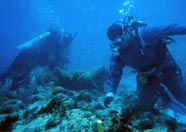
Two divers work to reattach a large fragment of elkhorn coral, Acropora palmata, at Mona Island, Puerto Rico. The coral in the background has been attached to the reef framework using stainless steel wires. The wire binds the coral fragment to the living coral where it is expected to reattach to the live coral. (Photo: Erik Zobrist, NOAA Restoration Center)
|
ecosystem restoration - actions taken to modify an ecosystem for the purpose of re-establishing and maintaining desired ecological structures and processes |
ecotone - a transitional area between two adjacent ecological communities |
ecotope - the abiotic or non-living part of an ecosystem |
ecotourism - travel undertaken to experience sites or regions of unique natural or ecological quality, or the provision of services to facilitate such travel |
ecotype - a genetically differentiated subpopulation that is restricted to a specific habitat |
ecotype - a population in a given ecosystem that is adapted to a particular set of environmental conditions |
ecozone - an area at the earth's surface representative of large and very generalized ecological units characterized by various abiotic and biotic factors |
ecteinascidin - a marine pharmaceutical derived from the sessile tunicate Ecteinascidia turbinata which acts by disrupting the structure of DNA in the cells of solid tumors |
ecto- - a prefix meaning 'outside' |
ectoderm - the outer germ layer of cells in an embryo that gives rise to the outer layer of skin (epidermis) and neural tissue |
ectodermis - the outer cellular covering of a polyp |
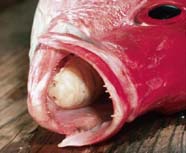
A marine ectoparasite lodged in a fish's mouth. (Photo: NOAA Ocean Explorer)
|
ectoparasite - a parasite which lives on the surface of its host |
ectoplasm - the clear, nongranular portion of the cell cytoplasm just inside the cell membrane |
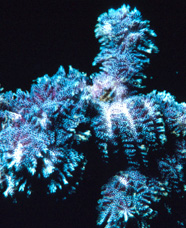
The Ectoprocta (Bryozoa) are tiny colonial animals that superficially resemble coral polyps. Most species are marine, and may be found on all types of hard substrates. (Photo: Shane Anderson)
|
Ectoprocta - an animal phylum synonymous with the phylum Bryozoa, the "moss animals" |
ectotherm - a cold-blooded animal, one which cannot internally regulate its body temperature, such as a reptile, fish, or amphibian, whose body temperature is mostly determined by the surrounding environment and behavior; poikiloltherm; cold-blooded organisms maintain their body temperatures in ways different from warm-blooded animals, such as mammals and birds |
ectothermic - having an internal body temperature that is dependent on the surrounding temperature. Most aquatic animals are ectotherms; also caled poikilothermal or "cold blooded" |
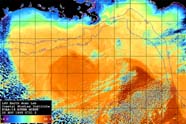
AVHRR image of eddy in the Gulf of Mexico. (Image: NOAA-14 Polar Orbiting Satellite/LSU Earth Scan Lab, Coastal Studies Institute)
|
eddy - a circular movement of water formed on the side of a main current |
edge effect - habitat conditions created at or near the more-or-less well-defined boundary between ecosystems (ecotone). Typically there is an increased richness of organisms resulting from the mixing of two communities where they join |
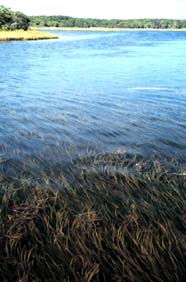
Eel grass meadows. (Photo: NOAA)
|
eelgrass - a common seagrass (Zostera marina) distributed from Greenland to Florida that serves as an important habitat for fishes and shellfish. Unfortunately, approximately 90 percent of all eelgrass throughout its range along the Atlantic coast has been destroyed |
effector - a muscle or gland that receives a stimulus from a neuron |
efferent - moving or carrying outward or away from a central part. Refers to blood vessels, nerves, etc. For example, blood vessels carrying blood away from the heart or nerve fibers conducting impulses from the brain or nerve cord |
effluent - a discharge of pollutants into the environment, partially or completely treated or in its natural state. Generally used in regard to discharges into waters; in contrast to an emmission, which is generally used in regard to discharges of pollutants into the air |
efflux - an outward flow; flux of water, elements or gases out of an ecosystem or ecosystem component |
effort - the amount of time and fishing power used to harvest fish. Fishing power includes gear size, boat size, and horsepower |
egestion - the elimination of undigested food materials from an organism |
egg - a female sex cell or gamete with the haploid number of chromosomes. It may be fertilized by a sperm cell to produce a zygote with the diploid number of chromosomes for that particular species. The eggs of some species may develop into multicellular individuals without being fertilized by a sperm cell. This is the process of parthenogenesis |
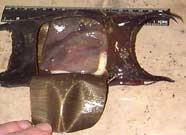
A skate egg case (Mermaid's purse) revealing the skate embryo contained within (Photo: David Siebenaller)
|
egg case - the leathery case which contains the developing embryo in hagfishes, sharks, rays, skates and chimaeras; also called a "mermaid's purse" |
egg chamber - a cavity or chamber in the sand, excavated by a nesting seaturtle, into which eggs are deposited for incubation |
Ekman layer - the thin horizontal layer of water riding on top of the ocean that is affected by wind |

Graphic of sea surface temperatures show El Niño, May 1997.
|
El Niño - an irregular variation of ocean current that from January to March flows off the west coast of South America, carrying warm, low-salinity, nutrient-poor water to the south. It is associated with the Southern Oscillation. These two effects are known as the El Niño Southern Oscillation (ENSO). El Niño usually occurs during the Christmas season when the equatorial counter current strengthens and flows eastward to overlie the cold, nutrient-rich waters of the Peru current. It does not usually extend farther than a few degrees south of the equator, but occasionally it does penetrate beyond 12 deg S, displacing the relatively cold Peru Current. The effects of this phenomenon are generally short-lived, and fishing is only slightly disrupted. Occasionally, the effects are major and prolonged |
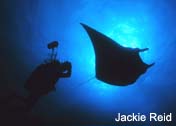
The manta ray is a large, graceful, mostly plankton-feeding elasmobranch. They also feed on small fishes. (Photo: Jackie Reid/Flower Garden Banks National Marine Sanctuary)
|
elasmobranch - a member of the Subclass Elasmobranchii of cartilaginous fishes. These include sharks, rays, and skates |
elastic - capable of returning to an initial form or shape after deformation; resilient |
electric field - the region extending outward in all directions from an electrically charged material that affects other electrically charged objects; the area around an electrified object where other charges are affected |
electrocyte - a cell that generates electricity. The electric currents produced by some species of fishes, such as torpedo rays and electric eels, are generated in stacks or columns of electrocytes.The electrocytes of most 'electric fishes' are modified muscle cells. They are usually arranged in columns within electric organs. When an electrocyte is stimulated, a movement of ions (electrically charged atoms) across the cell membrane results in an electric discharge |
electrogenic - capable of generating electric currents and a painful electric shock, as in electric rays |
electromagnetic radiation - energy that travels through space in the form of waves. The highest frequencies in the spectrum of electromagnetic radiation are gamma-rays; the lowest frequencies are radio waves. All electromagnetic radiation travels at the speed of light. Shorter wavelength radiation (eg, ultraviolet) carries more energy and is likely to be more harmful to living tissue |
electromagnetic receptor - a neurological receptor that responds to light, electricity, and magnetism. Photoreceptors respond to light and electroreceptors detect electrical energy |
electron microscope - a microscope which beams electrons, instead of light beams, at and through the object of interest. This type of microscope provides the greatest resolution of extremely small details in the nanometer size range. Magnification may be up to x300,000 |
electron spin resonance - a chronometric dating technique that estimates dates from observation of radioactive atoms trapped in calcite crystals present in a number of materials, such as limestone, coral, shells, teeth, and bones; also called "Electron Paramagnetic Resonance (EPR)" |
electrophoresis - a technique for separating different types of molecules based on their patterns of movement in an electrical field |
electroporation - the creation of reversible small holes in a cell wall or membrane through which foreign DNA can pass. This DNA can then integrate into the cell's genome |
electroreceptor - a receptor organ that senses changes in an electrical current in the surrounding water, for example, the ampullae of Lorenzini in sharks |
electrotaxis - the movement of organisms in response to an electric field |
eleutherobin - a marine pharmaceutical initially isolated from the soft coral Eleutherobia sp. from Western Australia, and more recently from Erythropodium caribaeorum, an encrusting coral found in South Florida and the Caribbean. Eleutherobin is a potent cancer cell inhibitor |
elevation - the height of a geographic location above a fixed reference point, often the mean sea level |
ELISA (enzyme-linked immunosorbent assay) - a rapid test where an antibody or antigen is linked to an enzyme as a means of detecting a match between the antibody and antigen; a technique for detecting specific proteins by using antibodies linked to enzymes |

The caudal fin of this trout has an emarginate shape. (Image: U.S. Fish and Wildlife Service)
|
emarginate - a notched margin, but not so deeply as to be forked. As an example, a trout possesses an emarginate caudal fin |
embayment - an indentation in the shoreline that forms a bay |
embryo - the stage of early growth and differentiation of tissues and the formation of primitive organs and organ systems of a multicellular organism, from fertilization until birth or hatching. In seed plants, it is the young sporophyte that resulted from the union of the egg and one of the two tube nuclei |
emergent vegetation - plants growing in water but emerging from it, usually at the water's edge |
emersed - rising above the water surface |
emigration - the movement of individuals out of a population or from one area to another |
emission - any substance that is discharged into the soil, air or water |
empirical - based on experience or observations, as opposed to theory or conjecture |
emulsion - a suspension of small globules of one liquid in a second liquid with which the first will not mix |
encrustation - a crustlike deposit or growth over a substratum |
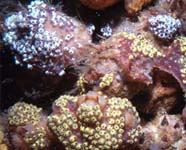
Encrusting tunicates at Gray's Reef off Sapelo Island, Georgia (Photo: Karen Angle).
|
encrusting colony - a thin colony which adheres closely and is attached to the substrate |
encryption - a process that transforms plain text or data and makes it unreadable to an outside party. The transformation is made using a mathematical formula and a "key," which is a special data item, usually kept secret, used as input into the formula along with the data. To read the data from the encrypted version the key and the formula must be known |

The Hawaiian monk seal is an endangered marine mammal (Photo: Dr. James P. McVey)
|
endangered species - under the Endangered Species Act (ESA), an endangered species is one that is in danger of extinction throughout all or a significant portion of its range |
Endangered Species Act (ESA) - an Act of Congress passed in 1966 that establishes a federal program to protect species whose survival is threatened by habitat destruction, overutilization, disease, etc. |
endangered taxa - taxa in danger of extinction and whose survival is unlikely if causal factors continue operating. Included are taxa whose numbers have been drastically reduced to a critical level or whole habitats have been so drastically impaired that they are deemed to be in immediate danger of extinction. Also included are those that possibly are already extinct, in so far as they have not been seen in the wild in the past 50 years |
endemic species - a species whose distribution is restricted to a particular area |
endergonic reaction - a chemical reaction that requires energy in order to proceed, so that the products have a higher free energy than the reactants |
endo- - a prefix meaning 'inside' |
endobenthic - refers to meiofaunal-sized organisms that move within the sediments |
endocoel - the space of the cnidarian gastrovascular cavity between two mesenteries belonging to one and the same pair |
endocrine gland - a gland that manufactures hormones and secretes them directly into the circulatory system to act at distant sites in the body |
endocrine system - the system of ductless glands in animals that secrete hormones |
endocytosis - uptake of material into a cell by the formation of a membrane-bound vesicle |
endoderm - the inner germ layer of diploblastic and triploblastic embryos that gives rise to internal tissues such as the gut and gut derivatives, e.g., air bladder, lungs, and the lining of the digestive tract |
endogenous - having its origin, or produced within the organism or one of its parts |
endogenous rhythm - a metabolic or behavioral rhythm that originates within the organism and persists regardless of external conditions |
endolithic - growing within a rock or any other hard inorganic substratum |
endolithic algae - algae which burrow into calcareous rocks or corals |
endonuclease - a nuclease that cleaves nucleic acids at specific internal sites |
endoparasite - a parasite which lives in the internal organs of its host |
endophytic - living within the tissues of a host plant or alga |
endopinacocyte - in sponges, a pinacocyte lining the incurrent and excurrent canals |
endopinacoderm - in sponges, a surface lined with endopinacocytes |
endoplasm - the granular portion of the cell cytoplasm between the ectoplasm and nuclear membrane |
endopodite - in crustaceans, the inner branch, or ramus, of a biramous appendage; the main shaft of that appendage; also called "endopod" |

Endoskeleton of a 35-ton, 13-m gray whale on the floor of the Santa Cruz Basin.
|
endoskeleton - skeleton, or support structure, which is on the inside of the organism's body. All vertebrates possess an endoskeleton that is made of either bone and/or cartilage |
endostatin - an endogenous protein that blocks the proliferation of blood vessels |
endosymbiont - an organism which lives within the body of another organism as part of a symbiotic relationship. The relationship may be mutualistic or commensalistic; also called an 'endobiont' |
endosymbiotic - being symbiotic and living within the body of an individual of the associated species |
endothecal dissepiment - one of many horizontal partitions across the corallite within the corallite wall |
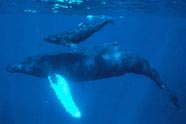
Whale fat (blubber) aids these humpback whales in maintaining a relatively constant body temperature. (Photo: Dave Matilla, NOAA/NOS National Marine Sanctuaries)
|
endothermic - an animal that is able to maintain a body temperature that varies only within narrow limits by means of internal mechanisms. Most birds and mammals are considered endothermic; also called homeothermal or "warm blooded" |
endothermic reaction - a reaction which absorbs heat |
endozoochory - the dispersal of plant seeds or spores within the body of an animal, as passing through the animal's digestive system; also called "endochory" |
endozooic - living inside an animal |
energy - the capacity for doing work. Forms of energy include light, thermal, mechanical, electrical, and chemical. Energy may be transformed from one form into another |
energy flow - the movement of energy through a community via feeding webs |
enrichment - the addition of nitrogen, phosphorus and carbon compounds or other nutrients into a lake or other waterway that greatly increases the growth potential for algae and other aquatic plants. Most frequently, enrichment results from the inflow of sewage effluent or from agricultural runoff |
ENSO (El Niño Southern Oscillation) - see El Niño and Southern Oscillation |
enterocoelous - the mesoderm and coelom initially develop as pouches off of the primitive digestive tract (archenteron) of an embryo. Enterocoelous development of the coelom occurs in deuterostomes |
enteron - the alimentary canal or the gut of an embryo. Some structures of the enteron may not be completely developed or differentiated in early embryonic growth |
entrainment - the synchronisation of one biological rhythm to another or to a zeitgeber cycle, e.g. circadian rhythms are often entrained to the light-dark cycle; also, the process of small organisms being captured in the cooling water of a power plant |
entropy - the measure of the disorder or randomness of energy and matter in a system |
environment - everything external to the organism |
environmental impact - a positive or negative effect of any action upon a give area or resource |
environmental impact assessment - detailed studies which predict the effects of a development project on the environment. They also provide plans for the mitigation of adverse impacts |
environmental impact statement (EIS) - a key component of an environmental impact assessment. An EIS provides a summary of the impact assessment study, including the main project characteristics, environment aspects most likely to be affected, possible alternatives, and suggested measures and systems to monitor or reduce any harmful effects |
environmental resistance - the limits set by the environment which prevent organisms from reproducing indefinitely at an exponential rate |
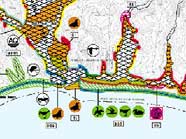
A section of an Environmental Sensitivity Index map, showing part of the Point Reyes National Seashore. Shorelines are color-coded to show their sensitivity to oiling. (Photo: NOAA)
|
environmental sensitivity index (ESI) map - ESI maps serve as quick references for oil and chemical spill responders and coastal zone managers. They contain three kinds of information: (1) Shorelines (color-coded to indicate their sensitivity to oiling); (2) Sensitive biological resources (such as seabird colonies and marine mammal hauling grounds. They are depicted by special symbols on the maps); and (3) Sensitive human-use resources (such as water intakes, marinas, and swimming beaches). Project scientists have created collections of ESI maps, called ESI atlases, for most coastal areas in the US, including Alaska, Hawaii, the Great Lakes, and the trust Territories. Each atlas includes maps and additional data and information. Starting in 1995 with the outer coast of California, ESI project members began using a Geographic Information System (GIS) to produce updated ESI maps that are higher in quality and can be more readily reproduced |
environmental sex determination (ESD) - the phenomenon in which the sex of the offspring is determined by environmental factors |

A catastrophic environmental stress-the 1989 grounding of the Exxon Valdez, which spilled an estimated 11 million gallons of crude oil over 1,300 miles of coastline.
|
environmental stress - severe environmental effects on the natural ecosystem |
environmentalism - advocacy for, or work toward, protecting the natural environment from destruction by human activities |
enzootic - an infectious disease constantly present in an animal population but having low incidence |
enzyme - an organic catalyst |
enzyme unit (EU) - a unit to measure enzymatic activity in cells. One enzyme unit is the quantity of enzyme needed to cause a reaction to process 1 micromole of substance per minute under specified conditions |
eon - a unit of time equal to 1 billion years |
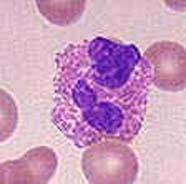
A human eosinophile. The smaller round cells are red blood cells.
|
eosinophile - a type of white blood cell (leukocyte) that engulfs and digests bacteria. Eosinophils, along with other types of white blood cells, are important in an organism's internal defense system |
ephemeral - short-lived, transitory |

Ephyra larva of the jellyfish Aurelia. (Photo: Rick Gillis, Ph.D., Biology Dept., University of Wisconsin-La Crosse)
|
ephyra larva - a jellyfish (Scyphozoa) larval stage that develops into the adult medusa or jellyfish |
epibenthic (epifaunal or epifloral) - refers to organisms living on the surface of the substrate |
epibiont - an organism that lives on the outside of another organism |
epicenter - the point on the earth's surface directly above the hypocenter, where the energy of an earthquake is first released |
epidemic - the widespread outbreak of a disease, or a large number of cases of a disease in a single community or relatively small area |
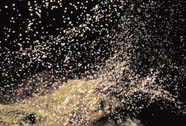
Star coral shedding gametes in an epidemic spawning event.
|
epidemic spawning - the simultaneous shedding of gametes by a large number of individuals |
epidermis - the outer epithelial layer of the body |
epifauna - animals that live upon or are associated with substratum features |
epilithic - growing on rock or stone. Epilithic organisms live attached to rocks |
epimeletic behavior - behavioral activities associated with care-giving or help to other individuals |
epipelagic zone - the surface layer of the ocean (also called the sunlight zone) which extends from the surface to 200 meters. Most of the visible light exists in this zone. Wide variations in temperature occur in this zone, both latitudinally and seasonally |
epipelic - living on or in fine sediments, such as mud or sand |
epiphyte - microalgal organism living on a surface (e.g., on a seaweed frond); a plant living on the surface of another plant |
epipsammic - attached to, or moving through, sand particles |
epistasis - the prevention or masking of the expression of an allele at one locus by an allele at another locus |
epistome - the flap over the mouth of some lophophorates |
epitheca - a layer of calcium carbonate that grows outside corallite walls |
epitheliomuscular cell - a columnar epithlial cell that contains contractile fibrils in cnidarians. Epitheliomuscular cells facilitate polyp movement and contraction |
epithelium - a tissue layer of cells which lines body cavities and tubules, or covers surfaces. The cells may be ciliated or non-ciliated, and may be squamous (flat, scale-shaped), cuboidal (cube-shaped), or columnar (column-shaped) in shape. The cells may occur in a single layer, or may be multi-layered (stratified) |
epithet - the second name of the binomial given to a species; the species name or second part of a Latin binominal. In the name "Homo sapiens," sapiens is the specific epithet |
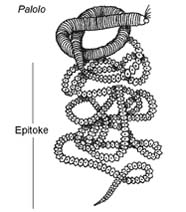
Palolo (Eunice viridis) are polychaete worms that are about 12 inches long and live in burrows dug into the coral pavement on the outer reef flat. The worm is composed of two distinct sections. The front section is the basic segmented polychaete with eyes, mouth, etc., followed by a string of segments, called the “epitoke,” that contain reproductive gametes. (Image: www.nps.gov)
|
epitoky - a mode of reproduction unique to polychaete worms in which the worm undergoes a partial or entire transition into a pelagic, sexually reproductive form, known as an epitoke. In many cases, epitoky involves loss or degeneration of digestive structures and enhancement of swimming, sensory, and reproductive structures. The epitoke is a considered a delicacy in some islands of the South Pacific. |
epizoite - an animal that lives on the surface of another organism |
epizootic - a temporal pattern of disease occurrence in an animal population in which the disease occurs with a frequency clearly in excess of the expected frequency in that population during a given time interval; an outbreak (epidemic) of disease in an animal population |
epizootiology - the study of the factors which determine frequencies and distributions of infectious diseases among non-human animals |
epoch - a division of geologic time next shorter than a period. Example: the Pleistocene epoch is in the Quaternary period |
equatorial current - an ocean current which flows westerly near the equator. There are two such currents in both the Atlantic and Pacific Oceans. The one to the north of the equator is called the North Equatorial Current and the one to the south is called the South Equatorial Current. The easterly flowing Equatorial Countercurrent lies between the Equatorial Currents |
equilibrium - the state in which the action of multiple forces produces a steady balance, resulting in no change over time |
equinox - either of the two times during a year when the sun crosses the celestial equator and the length of day and night are equal |
era - a division of geologic time next smaller than the eon and larger than a period. Example: The Paleozoic era is in the Phanerozoic eon and includes, among others, the Devonian period |
erectile - capable of being raised or erected, often referring to spines of bony fishes |
erg - unit of work measuring force of one dyne applied over one centimeter |
erosion - the wearing away of the land surface naturally by wind or water, but is often intensified by human's land-clearing practices. The runoff is harmful to coral reefs |
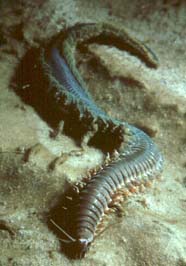
The polychaete Nereis sp. is an errant species of worm. (Photo: U.S. Geological Survey)
|
errant - motile or free swimming |
ERSST (Extended Reconstruction of SST) data set - a globally complete reconstruction of of sea surface temperatures (SST) based on in situ measurements and satellite data produced at a monthly, 2 degree resolution |
erythema - abnormal reddening of the skin due to the dilation of capillaries. Erythema may be due to a number of conditions, such as the sting of a venemous animal, and is often a sign of inflammation and infection |
erythrophore - a chromatophore which contains reddish pigments found in carotenoids and pteridines |
esca - in some fishes, e.g. frogfishes, the first dorsal fin ray is modified to function as a fishing pole and lure. The part close to the body is the illicium or fishing pole. The esca is the lure on the end of the illecium |
escape reaction - in animal behavior, a response to a predator or other dangerous situation, in which the threatened animal may flee, hide, or stay motionless in order to avoid contact |
escarpment - a steep slope or long cliff that results from erosion or faulting and separates two relatively level areas of differing elevations |
ESRI (Environmental Systems Research Institute, Inc.) - a world leader in GIS (geographic information system) software and technology |
essential amino acid - an amino acid that cannot be synthesized by animals and therefore has to be ingested with food |
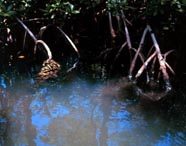
This tangle of red mangrove roots in the Jobos Bay, Puerto Rico National Estuarine Research Reserve is an essential fish habitat, serving as a both a nursery area and protection for many marine animals. (Photo: NOAA)
|
essential fish habitat - under the Magnuson-Stevens Fishery Conservation and Management Act, those waters and substrates that fishes require to spawn, breed, feed, or grow to maturity |
EST (expressed sequence tag) - a small part of the active part of a gene, made from cDNA which can be used to fish the rest of the gene out of the chromosome by matching base pairs with part of the gene. The EST can be radioactively labeled in order to locate it in a larger segment of DNA |
establishment - the subsequent growth and/or reproduction of a colonized species in a new territory |
ester - a chemical compound formed by the reaction of an organic or inorganic acid with an alcohol, with the elimination of water |
esthetasc - a sensory seta covered by cuticle projecting from most antennules and antennae in crustaceans |
esthete - a light sensitive organ in a minute vertical canal in the upper layer of the shell plate of a chiton |
estimate - the best guess arrived at after considering all the information given in a problem |
estimator - in statistics, an estimator is a function of the known data that is used to estimate an unknown parameter |
estuarine conditions - refers to saline and tidal conditions which occur due to tidal ebb and flow in a region where fresh and marine waters mix. Salinities and tidal ranges are typically less than those in the adjacent marine portion of the region, but more than those in the adjacent fresh water area |
estuary - a partially-enclosed coastal body of brackish water with one or more rivers or streams flowing into it and with a free connection to the open ocean |
et-epimeletic behavior - behavioral activities which solicit attention, care, or help from other individual; care-soliciting behavior |
ethogram - an inventory or catalog of all of the behavioral patterns of an organism or a species |
etiology - the science that is concerned with origins and causes of disease |
euchromatic - containing euchromatin, the extended regions of chromosomes. These extensions become most dense and thus most visible microscopically during the metaphase of the cell cycle; in a histological preparation, denotes any cell or tissue that stains the color of the stain used |
euchromatin - chromosome regions that are loosely packaged and more accessible to RNA polymerases than heterochromatin. These regions also stain differentially in chromosome banding preparations |
eudistomins - a family of marine pharmaceuticals, produced by the tunicate Eudistoma sp, which holds promise as potent antibiotic and anti-tumor drugs |
eukaryotic - descriptive of organisms with cells having a distinct nucleus with nDNA, and intracellular membranes. This includes all protists, fungi, plants and animals. The organisms are termed eucaryotes |
eumetazoa - all multicellular animals excluding the sponges |
euphotic depth - the depth to which significant phytoplankton photosynthesis can take place. It is typically taken to be the depth at which PAR falls to 1 percent of its value just below the surface |
euphotic zone - the layer of the ocean that receives sufficient sunlight for photosynthesis. The depth to which 1% of incident light penetrates (1% is the minimum amount of light required for photosynthesis) |
euryhaline - pertaining to an aquatic organism that can withstand a broad salinity range |
euryokous - adapted to numerous ecological niches |
euryphagous - describes an organism which gains its nourishment from a large variety of foods |
eurytele - a type of nematocyst |
eurythermal - pertaining to an aquatic organism that can withstand a broad temperature range |
eustatic - pertains to world-wide change in sea level, such as that caused by tectonic movements or expansion or contraction of glaciers |
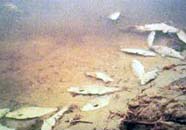
Eutrophic conditions can result in large fish kills, as many fish die from reduced levels of oxygen in the water.
|
eutrophic - a situation in which the increased availability of nutrients such as nitrate and phosphate stimulates the growth of plants such that the oxygen content is depleted and carbon sequestered |
evagination - protrusion of some part or organ from its normal position; the act of turning inside out; an outgrowth or protruded part |
evanescent - short-lived; temporary; soon disappearing |
event - in probability, an event is an occurrence or the possibility of an occurrence that is being investigated |
everted - turned inside out |
evo-devo (evolutionary developmental biology) - a relatively new approach in biology that seeks to explain the causes biodiversity. It attempts to integrate every area of biology from molecular genetics through embryology, molecular and population genetics, comparative morphology, paleontology, molecular evolution, ecology and functional morphology. It offers both an account of developmental processes and also new integrative frameworks for analyzing interactions between development and evolution. A major challenge lies in integrating these approaches to understand the evolution of biodiversity at a mechanistic level. The "evo-devo" community needs access to genomic information on a wide range of organisms |
evolutionarily significant unit (ESU) - a population or group of populations that is considered distinct (and hence a "species") for purposes of conservation under the Endangered Species Act. To qualify as an ESU, a population must 1) be reproductively isolated from other conspecific populations, and 2) represent an important component in the evolutionary legacy of the biological species |
evolutionary significant unit (ESU) - a group of organisms that has undergone significant genetic divergence from other groups of the same species. Identification of ESUs is based on natural history information, range and distribution data, and results from analyses of morphometrics, cytogene |
evolutionary tree - a lineage designed to show the evolutionary history of relationships among groups of organisms |
ex situ conservation - the preservation of components of biological diversity outside their natural habitats, e.g., in zoos, aquaria, botanic gardens and gene banks |
exaptation - in evolution, a biological adaptation where the biological function currently performed by the adaptation was not the function performed while the adaptation evolved under earlier pressures of natural selection |
excitotoxin - a toxic molecule that stimulates nerve cells so much that they are damaged or killed. For example, domoic acid, a toxin produced by certain species of algae. Domoic acid binds to a receptor that helps nerve cells control the flow of ions across their cell membranes. The receptor no longer works correctly, and the uncontrolled flux of ions damages and eventually kills the nerve cell |
Exclusive Economic Zone (EEZ) - the sovereign waters of a nation, recognized internationally under the United Nations Convention on the Law of the SEA as extending out 200 nautical miles from shore. Within the U.S. the EEZ typically is between three and 200 miles from shore |
excretion - a physiological process, originating in cells, that removes waste materials produced by the body |
excurrent canal - in sponges, an excurrent canal discharges water received from the apopyle, into the spongocoel (atrium). The water then passes through the osculum or oscula to the outside |
Executive Order - one of a number of official documents, numbered consecutively, through which the President of the United States manages the operations of the Federal Government |
Executive Order 13089 - on June 11, 1998, President Clinton issued Executive Order 13089 directing all agencies to increase their efforts to protect our nation's coral reef resources. The executive order calls for the establishment of a U.S. Coral Reef Task Force, cochaired by the Secretaries of the Interior and of Commerce. The Task Force will develop and implement a comprehensive program of inventory, monitoring, and research to map and identify the major causes and consequences of degradation of coral reef ecosystems |
Executive Order 13158 - on May 26, 2000, President Clinton signed Executive Order 13158 on Marine Protected Areas (MPAs) to strengthen the protection of U.S. ocean and coastal resources. This significant milestone in ocean conservation directs the Departments of Commerce and the Interior, and other federal agencies, to strengthen and expand a national system of MPAs by working closely with state, territorial, local, tribal, and other stakeholders |
exergonic reaction - a chemical reaction that releases energy |
exhalant system - in sponges, part of the aquiferous system between the apopyle and the and osculum |
EXIF format - EXIF stands for Exchangeable Image File Format, and is a standard for storing interchange information in image files, especially those using JPEG compression. Most digital cameras now use the EXIF format |
exocoel - the spaces of the gastrovascular cavity of cnidarians located between two mesenteries belonging to different pairs |
exocrine gland - a gland that secretes its product through a duct |
exogenous - having its origin external to the organism or ecosystem |
exogenous deoxyribonucleic acid (DNA) - refers to any deoxyribonucleic acid (DNA) which originates outside of the organism of concern or study; also referred to as foreign DNA or heterologous DNA |
exon - a nucleotide sequence (of DNA or RNA) in a gene that codes for part or all of the gene product or for some control function. In eukaryotes, exons are separated by non-coding sequences called introns; that part of the gene (a section of DNA) that is transcribed into messenger RNA and encodes a protein |
exopinacoderm - the unicellular external surface of a sponge (ectosome composed of pinacocytes) |
exopodite - in crustaceans, the outer branch, or ramus, of a biramous appendage; also called "exopod" |
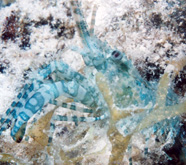
This shrimp possesses a beautiful aquamarine exoskeleton. (Photo: David Burdick)
|
exoskeleton - an external skeleton or supportive covering of an animal formed from the ectoderm, as for example, the shell coverings of a crustacean, the calcium carbonate secretions of stony corals, or the bony plates of an armadillo |
exothecal dissepiment - a horizontal partition outside of the corallite wall |
exothermic reaction - a reaction that gives off heat |
exotic species - a non-native species that is introduced into an area; also referred to as alien or invasive species |
exozoochory - the dispersal of plant seeds or spores accidentally attached to the outside of an animal's body; also called "epizoochory" |
expected value - in statistics, the mean value calculated for a statistic over an infinite number of samples |
explanate coral colony - a colony that spreads horizontally as the branches fuse into a solid or near solid plate |
exploitation - the removal of individuals or biomass from a population by predators or parasites |
exponent - an expression of the number of times that a base is used as a factor |
exponential growth - growth in the size of a population in which the rate of growth increases as the size of the population increases; change in a population growth rate that is proportional to the size of the population |
exposure - contact with infectious agents such as bacteria or viruses in a manner that promotes transmission and increases the likelihood of disease |

Arctic diver with rebreather and heated dry suit prepares to descend into the ice. (Photo: NOAA/OAR/National Undersea Research Program)
|
exposure suit - a full or partial garment that is worn by scuba divers for protection against heat loss. Water conducts heat away from the body about 20 times faster than air. In addition to providing warmth, exposure suits also serve to protect from minor scrapes, stings and abrasions. There are three kinds of exposure suits: wet suits, which allows water to seep in between the insulated rubber covering and the skin. They come in a variety of thicknesses suitable for insulation in water as cold as 50 degrees F; body suits, made from Lycra or nylon.They provide full length abrasion protection, but only minimal insulation; and dry suits which are water-tight garments that keeps the divers body warm by providing insulation with a layer of gas, such as air. It is used for diving in waters that are too cold for comfortable wet suit protection, usually below 65 degrees F |
extant - of a taxon: having living representatives; of a specimen: still in existence |
extant species - species which are now living |
exteroreceptor - a neurological receptor that receives information from the environment external to the organism |
extinct - of a taxon: having no living representatives. |
extinct species - species for which there are no living representatives |
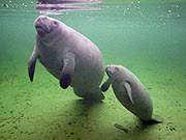
Manatees are threatened with extinction from both habitat destruction and direct effects from human encroachment, such as serious wounds from boat propellors.
|
extinction - the evolutionary termination of a species caused by the failure to reproduce and the death of all remaining members of the species; the natural failure to adapt to environmental change |
extinction coefficient - a coefficient measuring the rate of extinction, or diminution, with distance of transmitted light in sea water |
extirpated species - a species that has been destroyed or removed completely from a particular area, region, or habitat. The species, however, may exist elsewhere, e.g., in a zoo or aquarium |
extra-embryonic membrane - membranes possessed by amniote (reptiles, birds, and mammals) embryos that allow these classes of vertebrates to be free of aquatic habitats for reproduction, and in their evolution, occupy terrestrial habitats. The membranes are the amnion, yolk sac, allantois and chorion |
extracellular digestion - a form of digestion that takes place within the lumen of the digestive system. The resulting nutrient molecules are transferred into the blood or body fluids through the process of absorption |
extratentacular budding - an asexual form of reproduction where daughter corallites grow from the outside wall of the parent corallites |
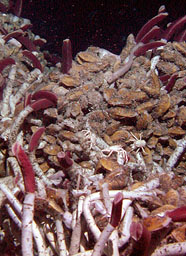
Crowded life in an extreme environment—Riftia tubeworms, mussels, and scavenging crabs found at a hydrothermal vent site in the Pacific Ocean. Most hydrothermal vents are found at an average depth of about 2,100 meters (7,000 ft) in areas of seafloor spreading along the Mid-Ocean Ridge system. (Photo courtesy of C. Van Dover.)
|
extreme environment - an environment characterized by extremes in growth conditions, including temperature, salinity, pH, among others |
extremophile - a microorganism that lives at extreme levels of pH, temperature, pressure or salinity |
extrinsic - not forming an essential part of a thing; arising or originating from the outside |
extrinsic factor - a biotic or abiotic factor acting on an organism or population from outside the organism or population.These are the physical and chemical features of the environment, as well as other organisms |
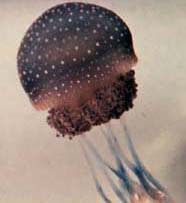
The rounded upper surface of this jellyfish is the exumbrella.
|
exumbrella - the upper surface of the bell of a medusa or jellyfish |
Eye-in-the-Sea - a video camera capable of operating in deep water (up to 3,000 ft) for days at a time. It is mounted within a steel structure and anchored to the seafloor by its own weight |
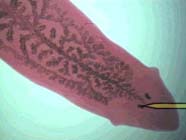
Eyespots of a free-living flatworm, Planaria dugesia.
|
eyespot - any light-sensing structure in some primitive organisms that consists of a pigmented area and light sensitive cells; also called an ocellus |
|
|
|
|

